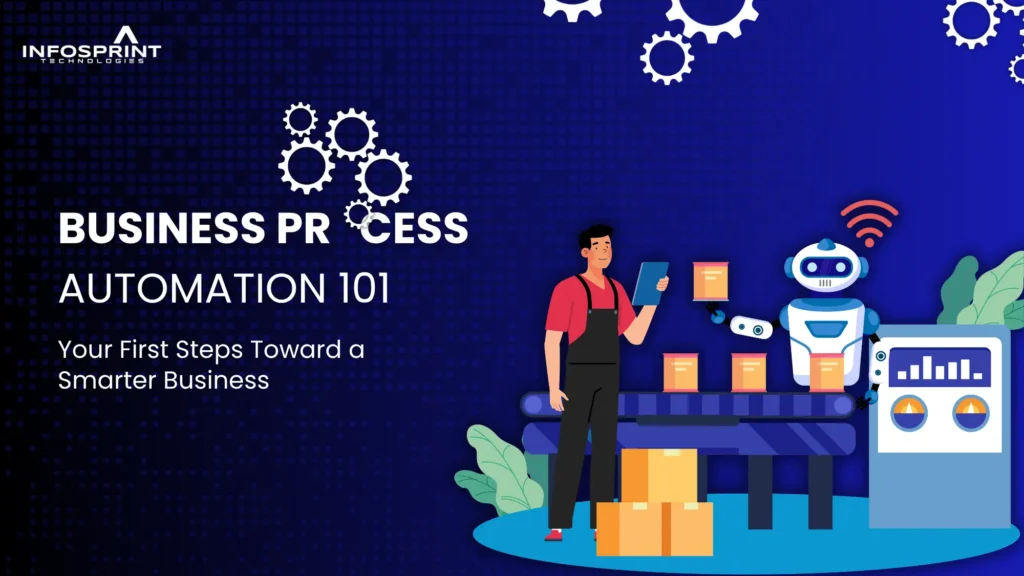Business Process Automation 101: Your First Steps Toward a Smarter Business

- Business process automation and its current landscape
- Is Your Business Ready for Automation? Identify Key Processes Now
- A Guide to Selecting and Implementing Effective BPA Technologies
- A Step-by-Step Guide to design efficient workflows
- Don’t Rush Automation, Pilot It
- Monitor, measure, and optimize
- Reimagine Your Business with the Power of BPA
Efficiency is the key to the company’s productivity, scaling, and growth. In today’s world, automation has become the key to increased productivity, staying in the market longer, being competitive, and pursuing new business opportunities and revenue-generation models. Infosprint Technologies, a leading IT consulting company, follows RPA automation to automate its tasks and is eager to share its tips and findings through this blog. We will delve into the best practices for successful business process automation.
Business process automation and its current landscape
Business process automation (BPA) is a methodology for automating repetitive, rule-based tasks within a business process. These duties range from straightforward data entry to intricate departmental operations. Businesses can focus on intricate areas that need their attention and optimize their task potential with BPA.
- Increased efficiency: By automating monotonous chores, employees can concentrate on more strategic and creative work. Automation can significantly accelerate tasks, improving customer satisfaction and turnaround times.
- Enhanced accuracy: Automation reduces the errors and risks caused by a manual workforce while maintaining consistent quality and adhering to standards.
- Increased cost-efficiency: Automation can lower overhead and labor costs. Businesses can optimize their resource utilization by simplifying their operations.
- Enhanced customer experience: Automated procedures might result in faster response times to consumer requests and questions. Automation can facilitate the delivery of consistent, high-quality services.
Is Your Business Ready for Automation? Identify Key Processes Now
Identifying and understanding business processes that generate high yields for successful business automation is crucial. Not every method is suitable for automation. It is best to prioritize the following:
Repetitive tasks
Prioritizing repeated and high-impact tasks that substantially influence productivity and resource allocation and require regular, consistent actions is crucial for automating workflows. Concentrating on these jobs can save businesses significant time, increase accuracy, and free up staff members to work on more strategic projects.
- Data entry: Manual data entry takes a lot of time and is prone to mistakes. Examples include updating inventory records, entering financial data into accounting software, and entering customer information into a CRM system. Automation speeds up the data entry process and eliminates errors. This is incredibly impactful in sectors like retail, finance, and healthcare, where high volumes of data must be processed reliably.
- Report generation: Most organizations require regular reports to track and monitor their performance, sales, inventory, etc. These reports are collected from various sources and compiled together to analyze the data to be shared with stakeholders. However, this process is labor-intensive and time-consuming, and there are cases where the statistics don’t match the analysis. Automation, however, takes the data from various sources and compiles it without error or human intervention. An RPA bot can do this.
- Customer support: Order monitoring, account balance checks, and frequently asked questions are examples of repetitive client inquiries ideal for automation. These routine questions usually take up much of a customer support agent’s time, preventing them from concentrating on more complicated client problems. Companies can increase client happiness and reduce support costs—staff for higher-value interactions by using chatbots or virtual assistants to promptly and adequately answer common questions.
Stakeholder involvement
When implementing automation, seeking suggestions from those directly involved is vital. Their advice is crucial for precisely defining each stage, comprehending problems, and ensuring that the automation solution satisfies the company’s demands.
- Accurate process mapping and insights: Each step, including subtleties that might not be recorded or apparent at higher levels, is understood personally by team members who routinely carry out the tasks being automated. They understand the process’s particular needs, dependencies, and possible bottlenecks.
- Identifying pain points: Frontline employees best understand the repetitive tasks and where bottlenecks and errors occur. They know which process causes time delays and which requires automation and data entry.
- Avoiding over- and under-automation: Stakeholders help ensure that automation is not too broad or too narrow. They focus on ROI and optimizing resource allocation.
A Guide to Selecting and Implementing Effective BPA Technologies
After understanding the right business processes, BPA, organizations must focus on the right tools and technologies to integrate into their business process automation, exploring new technologies, accessing user-friendliness, and whether the tool features meet the business goals and objectives.
Understanding tool compatibility:
In any digital transformation company, it is essential to check if the automation tools are compatible with the organization for seamless integration. When new tools integrate smoothly with existing systems, transitioning to using them is much easier. They also ensure data consistency, allowing data to be accessed and updated across multiple platforms in real-time. Compatible and scalable tools reduce the need for frequent troubleshooting, manual integration, and ongoing maintenance. This reduces the burden on IT teams and the likelihood of system failures and compatibility issues.
Exploring BPA technologies:
Business Process Automation offers various technologies for different tasks, and companies must explore all the tech to find the right solutions for their business.
- RPA: Robotic process automation is a bot that follows specific instructions and mimics human actions to perform repetitive tasks that require minimal decision-making.
- AI-drive automation leverages machine learning and performs predictive analysis to assist in human decision-making.
- Workflow automation platforms: These platforms automate end-to-end processes, enabling users to set up trigger-action workflows that link disparate systems.
Accessing user friendliness
When integrating automation tools, ensure they are user-friendly and provide support services. Even the best technology in the world falls short if the employees can’t use the tool effectively. Employees can gain confidence more rapidly when they use tools that are easy to use and have intuitive interfaces since they require less time to learn how to use them. Input errors caused by complex tools can slow down workflows and lower productivity. Having round-the-clock support is essential for businesses with international teams or extended hours. Robust assistance is frequently necessary when integrating a new tool with pre-existing systems.
A Step-by-Step Guide to design efficient workflows
An essential first step in comprehending and streamlining workflows for automation is to create a visual map of the process. Process mapping gives a clear and thorough workflow picture by diagramming every action, decision point, and phase.
Importance of process mapping:
An essential first step in comprehending and streamlining workflows for automation is to create a visual map of a process. Process mapping gives a clear and thorough workflow picture by diagramming every process action, decision point, and phase. With this effective visual representation, teams can find inefficiencies, pinpoint improvement areas, and ensure automation efforts are focused on the appropriate activities.
Designing for efficiency:
Designing for efficiency is crucial when automating or streamlining workflows to guarantee that procedures are resilient, transparent, and seamless. Efficient workflows reduce unnecessary processes, speed up turnaround, and better allocate resources, increasing production.
Consulting process owners:
Process owners must be involved in workflow refinement to achieve effective, pertinent, and long-lasting improvements. They usually monitor and control particular workflows or operations and have essential insight into the daily responsibilities, regular problems, and specific needs inside a process. Because of their insights, organizations can make intelligent adjustments that are genuinely in line with the particular requirements of each workflow.
Don’t Rush Automation, Pilot It
Before integrating automation software across the organization, launch a small pilot program to gather data and conduct a survey to get employee feedback instead of immediately launching into a complete implementation.
Risk mitigation and issue identification:
A pilot enables teams to see how automation works practically, spot any possible problems, and get input. Limits the impact of any technical issues or errors on a small segment of the organization, protecting core business operations from unintended consequences. This strategy reduces risk, maximizes resources, and offers insightful information that aids in creating a scalable, successful automation implementation.
Iterating based on pilot results:
The pilot program aims to test the technology and gather data, insights, and efficiency about suitable automation tools. Errors or inconsistencies may occur during a pilot, particularly in processes involving complicated decision-making procedures or many inputs. Pilots may show that to handle exceptions more precisely, and some rules require improvement or the addition of new criteria. Gather employees’ input to understand the tool’s pain points, speed, accuracy, and utility. Through a carefully managed iterative approach, organizations can achieve a high level of automation readiness, user satisfaction, and strategic alignment for long-term success.
Monitor, measure, and optimize
To fully realize the benefits of business process automation, ongoing tracking, and optimization are essential. Monitoring and modifying the key performance indexes in real time will optimize the tool for business goals and make it practical for changing business needs.
Continuous tracking and measurement:
Organizations may assess automation’s effectiveness and pinpoint improvement areas by routinely monitoring automation KPIs, including cycle time, mistake rates, and process efficiency. Businesses can identify any early deviations from their planned aims and take proactive measures by regularly monitoring these indicators. KPIs also act as standards that match BPA performance to general company goals like compliance, cost cutting, or customer happiness.
Scaling BPA across other processes:
Expanding automation to more areas can boost productivity and optimize return on investment when a first BPA endeavor is successful. Organizations should identify other high-impact, repetitive jobs that would benefit from automation, including time-consuming stages or substantial data handling. By progressively implementing BPA across departments or operations, businesses can increase overall agility, save operating costs, and boost productivity gains.
Reimagine Your Business with the Power of BPA
As highlighted, Business Process Automation is a technique for radically improving how companies function, not just a tool for increasing production. By automating repetitive, rule-based workflows that deplete resources and impede growth, BPA helps businesses improve customer service through AI-driven replies and automate high-frequency tasks like data entry and report generation. Companies can maintain their competitiveness, enhance customer satisfaction, and create new business opportunities by adopting a strategic approach to BPA. In addition to promoting operational efficiency, BPA creates a solid basis for future expansion and flexibility in a constantly changing market.
Related Posts

Top 10 Cloud Computing Technologies to Look Out for in 2025

Consistent Diagnosis: The Cornerstone of Modern Healthcare




